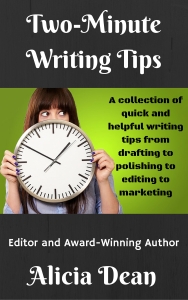Got two minutes? Then check out this week’s quick tip ~ Advice for writing genuine, realistic suspense.
Hello and welcome…I am a freelance editor and an editor for The Wild Rose Press, as well as an author. I often struggle with my own writing, and I have found that sometimes, a little reminder of ways to improve the process can be helpful, so, I like to share these moments of brilliance with others :). But, in this busy world of ours, who has time for pages and pages of writing tips? That’s why I’ve condensed mine down to quick flashes you can read in (approximately) two minutes. Enjoy…
Disclaimer: All of my tips are suggestions, and are only my opinion. And, for the most part, there are exceptions when going against my advice will make your story read better. Take what works, leave the rest.
I love suspense (and when I say suspense, I’m using it as an all-encompassing genre to include thrillers, mysteries, and police procedurals.) It’s my favorite genre to read and write. It’s also one of the most difficult, in my opinion. Writers have to be very careful about the way the crimes are presented, the way they are investigated, and how they are wrapped up.
Here are a few devices I see often and have probably done, although I try my best to avoid them:
1) The Scooby Doo Effect
Remember in all the Scooby Doo cartoon episodes when the end comes and the criminal is busted, and he reveals all the details of his diabolical plan and says, “And I’d have gotten away with it too, if it weren’t for those meddling kids.”
This worked well in the cartoon, but it’s not a good device in writing suspense. You’ve seen it in books, I’m sure. That moment at the end when a killer is caught and confronted by the main character. The perpetrator explains his entire plan and motive in detail. While it might be necessary to show a brief explanation, it needs to be natural, and there needs to be a legitimate reason for the criminal to explain. Criminals are not as anxious to spill their guts as many books would have you to believe. Most are anxious to do two things; commit crimes and get away with them. If the actions of your villains show otherwise, you might want to rethink your scene. And, please when it’s necessary to have them explain pieces of the puzzle that your characters, and therefore readers, would have no other way of knowing, try to let it evolve naturally in the moment.
In a book I read recently—we’ll call it Book X because I don’t want to give the real title, and I’ll be using it in all my examples—at the end, the killer had the female detective captive, and he felt the need to brag to her, explicitly, about how he pulled off the crime, and how he would still get away with it, once he disposed of her (that meddling detective), about how great it was to be so powerful and how his power and connections had allowed him the freedom to get by with those murders, and he went into great detail about all the players involved and their role in his scheme and his opinion on each. He basically outed himself as a narcissistic sociopath, and people rarely diagnose themselves like that. While all too typical, this type of ending scenario is unnecessary and unbelievable.
Here is a brief snippet from one of my novels. Details have been tweaked to prevent spoilers.
I drew the .22 from my jacket pocket and leveled it at him. “You’re insane. I want an answer, and I want it now. Otherwise, I put a bullet through your evil brain.”
His gaze went from the gun, up to my eyes, back to the gun, then settled on my face. The innocent mask fell. A touch of smugness came over his features. “I did it for you. For us.”
“What do you mean, for us?”
The now unguarded hazel eyes shone with maniacal glint. “Well, partly I took her to punish her dad and that blah, blah, blah, but I also figured I could use it as leverage.”
“Is she alive?” That was the burning question. Once I found out, I could proceed with trying to pick apart his demented mind and get the answers I needed.
“She’s fine. I couldn’t hurt her. Not knowing what she meant to you. I hoped I could convince you to go away with me if I promised to let the police know where she is. I was going to wait until we were far away from here before I told them. Until it was too late for you to change your mind.”
See, the bad guy has a good reason for revealing details. He’s trying to convince her to understand him and maybe to come away with him. And, I didn’t give a great deal of information. Just a few pieces.
2) Incognito Villains
This is when you want to show scenes from your villain’s point of view, but you do not wish to reveal their identity. This can be tricky, I’ll admit, and sometimes, it’s not easy to pull off. I definitely do not always succeed. One thing you definitely want to avoid is using a word when referring to the villain that makes it obvious you are trying to hide the identity. Words like, “The person,” “the shadow,” or even “the man” get tiresome and they make your scene unnatural and jarring. Sometimes, when not overdone, “the man” or “the woman” or “he” or “she” can work, but writers don’t always want to reveal the gender of their villain.
In Book X, the way the author presented scenes from the killer’s POV was to call him, or her, “the figure.” Trust me, this became annoying quickly. With lines such as… (these are not verbatim, but close):
The figure motioned the woman over to the car. She leaned in and gave the figure a sexy smile. She had no idea her life was about to end.
“Get in,” the figure said.
“Not so fast. We haven’t discussed rates.”
The figure’s grip on the steering wheel tightened. “I’ll pay whatever you want.” The figure had no intention of paying her a dime. She’d be dead before she could collect.
She winked and leaned in. The figure choked back the urge to gag at the smell of her cheap perfume.
Okay…so you get the idea. How distracting and annoying is that? I found myself thinking of ‘the figure’ in terms of the amount he would pay her, and making up jokes in my head. You do NOT want readers that distracted.
There are a few solutions, but as I said, they can be tricky. Especially if you want to hide the sex of the villain. The only solid solution I can think of for hiding gender is to write the villain POV scenes in first person. I know some authors dislike writing in first person and do not want to change from first to third points of view in various scenes. But, it’s probably the best way. See how much better this flows, and you do not know if the character is male or female:
I motioned the woman over to the car. She leaned in and gave me a sexy smile. She had no idea her life was about to end.
“Get in,” I said.
“Not so fast. We haven’t discussed rates.”
My grip on the steering wheel tightened. “I’ll pay whatever you want.” I had no intention of paying her a dime. She’d be dead before she could collect.
She winked and leaned in. I choked back the urge to gag at the smell of her cheap perfume.
You could also try giving the villain a nickname, but it would be difficult to hide when he or she appears in other scenes, where we DO know their identity, we just don’t know they are the killer. In one of my novels, I believe I pulled off the nickname thing successfully, since the ‘real’ name was only mentioned a few times in the story. And, if readers had thought hard enough about it, they might have connected. In another novel, I had my villain refer to himself as the fake name he gave when he approached young women. Therefore, in narrative, I could still call him by that name.
3) The Dr. Evil Plan – (please watch the below SHORT video)
This is funny, but it’s also pretty accurate in many suspense novels. Haven’t you read books where almost this exact thing happens? I know I have. Recently, in fact. Yes, it’s that Book X again (which, I might add, is a highly successful book, so I shouldn’t judge, but it did give me lots of material for a blog post, so judge I shall :))
In Book X, the killer has murdered 5 women, taken his time, and gleefully strangled and tortured them, reveling in watching the life fading from their eyes. At the end, when he is holding the female detective, along with the corpse of his sixth victim, he buckles the detective and the corpse into seat belts and sends the car into a water-filled quarry. Guess what? Help arrives, and the detective survives. Huh??? I’m not buying it. Why did he ‘Dr. Evil’ it and ‘assume all went according to plan’ rather than strangling her as well? He hated her, wanted her dead, had already made an attempt on her life, and she was the one who caught him. Sorry, but it just made no sense. This is a convenient, contrived device and readers find it annoying.
What I try to do in my suspense books is to make sure that there is a good reason for the killer to keep the main character alive, and sometimes show that it’s their MO (Mode of Operation), until I’ve figured out a way for my characters to get out of the mess they’re in. For example, in one of my books, the killer was exacting revenge against his wife who cheated and dumped him. With his other victims, he taunted and tormented them before killing them. When he had his cheating wife and her cheating new boyfriend held hostage at the end (and the main character stumbled onto the scene and was taken captive as well), he took time to screw with them and torment them to make them suffer. It wasn’t contrived, or at least I don’t think it was, because it made sense based on his history and his reasons for doing so.
So, while I must apologize that this tip was probably a bit longer than the promised two minutes, I feel these are important things to keep in mind in order to write a solid, believable suspense. The above devices are lazy and convenient ways to wrap up a case and reveal information to characters and readers, but these things cam be accomplished in much better ways.
Until next time…Happy Writing!
~*~*~*~*~*~*~*~*~*~*~*~*~*~*~*~*~*~*~*~*
NEW RELEASE – Now Available
(Click on the cover to be taken to the Amazon Buy Page)
~*~*~*~*~*~*~*~*~*~*~*~*~*~*~*~*~*~*~*~*
*** If you would like to send me a few sample pages (around 7500 words or so, even though I will not edit that many on the blog. It just gives me more to choose from) for me to edit and share on an upcoming blog post, please do so in the body of an email to AliciaMDean@aol.com. Please use the subject line: “Blog Submission” This is for published or unpublished authors. In the email, please include whether you would like me to use your name or keep it anonymous, and whether or not you would like me to include any contact info or buy info for your books. Also, you can let me know if you would like for me to run my edits by you before posting on the blog. Please keep in mind, this is for samples to use for blog posts. I will not edit or use samples from all the submissions I receive, but I will use as many as possible.
~*~*~*~*~*~*~*~*~*~*~*~*~*~*~*~*~*~*~*~*
How to write a novel? That is the question. There are probably as many answers to that question as there are people who ask it.
Wanting to write and actually doing it are two very different things. I am well acquainted with the sometimes grueling process of churning out a story. Over the years, I have tried many methods for creating and completing manuscripts, and have tweaked and honed it down to a workable (for me) process.
Using specific examples from one of my own novels, Without Mercy, I share my method in this mini how to book. The first eight steps actually deal with plotting while the last two are designed to help expand your outline into a well-developed draft. There is no one, perfect way to create a story, but there will be a method, or methods that work for you. I’m not sure if this is the one, but it works for me. Only you can decide if it also works for you. Fingers crossed that it does!
*** Warning – Please do not purchase without reading a sample. (This is solid advice for any book, fiction or non. If you are not intrigued in the sample, you will likely not enjoy the book)
Amazon: Click Here





Always great advice Alicia!
Thanks for sharing your expertise.
Good luck and God’s blessings
PamT
LikeLike
My pleasure. 🙂 Thank you for visiting!
LikeLike
Great tips- thank you!
LikeLike
You’re welcome…thank you!
LikeLike
Fun to read and now I know why I do not write “crime” stories! Thanks for posting.
LikeLike
Haha, yeah, they can be difficult. 🙂 Thanks for stopping by!
LikeLike
Now I want to know the title of Book X. LOL Good tips.
LikeLike
LOL. I’ll email you. 🙂 It’s actually on sale for 99 cents, so even though you have spoilers, it’s worth a read just to see if you think I was too harsh. 🙂
LikeLike
This was great. The way you fixed the problem of using “the figure” or “the man” makes a lot of sense. I’m reading a book right now that keeps calling the bad guys “the man”. There is a group of them. And when they are all in the same room, the author then refers to them as “the man at the table”, “the man at the window”, etc. It’s hard to keep track of who the leader of the bad guys is. Thanks for the post.
LikeLike
Thanks so much! Ugh, yes, with a group of villains you’re trying not to identify, that could get really annoying.
LikeLike
Helpful as always. Thanks!
LikeLike
You’re welcome…thank you!
LikeLike
You’re right, suspense is tricky! You don’t want the killer’s identity to be to obvious, but you don’t want it to come out of left field either. And let’s face it, obvious isn’t the same for everyone. Nice job, Alicia!
LikeLike
Exactly, and no matter what you do, you will not please all readers. You just have to tread carefully and not make obvious mistakes. 🙂 Thank you!!
LikeLike
Great tips! Thanks for sharing.
LikeLike